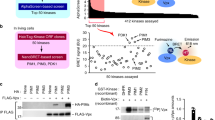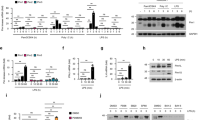Abstract
Phosphatase and tensin homolog deleted on chromosome ten (PTEN) is a well-known tumor suppressor that acts as a dual-specificity phosphatase and is frequently mutated in human cancer. Our previous work has demonstrated that PTEN also plays a vital role in type I interferon responses and antiviral innate immunity. Recently, a translational variant of PTEN with a long N-terminal extension (PTEN-L) has been discovered that is secreted into the extracellular environment and enters recipient cells, where it exerts a phosphatase function antagonistic to PI3K/Akt signaling and tumorigenesis. In this study, we demonstrate that PTEN-L promotes type I interferon responses and antiviral innate immunity during viral infection in a phosphatase activity-dependent manner. Compared with canonical PTEN, PTEN-L also exerts its antiviral function when it is applied exogenously in protein form. This finding was confirmed in cell cultures and mouse infection models. Furthermore, PTEN-L enhances the responses of both type I interferon and proinflammatory cytokines, thus suggesting that PTEN-L might possess additional functions compared with those of PTEN. Thus, the antiviral function of PTEN-L may open an avenue for the use of PTEN-L in antiviral therapy, particularly in patients with PTEN-deficient tumors.
This is a preview of subscription content, access via your institution
Access options
Subscribe to this journal
Receive 12 digital issues and online access to articles
$119.00 per year
only $9.92 per issue
Buy this article
- Purchase on Springer Link
- Instant access to full article PDF
Prices may be subject to local taxes which are calculated during checkout






Similar content being viewed by others
References
Li J, Yen C, Liaw D, Podsypanina K, Bose S, Wang SI et al. PTEN, a putative protein tyrosine phosphatase gene mutated in human brain, breast, and prostate cancer. Science 1997; 275: 1943–1947.
Steck PA, Pershouse MA, Jasser SA, Yung WK, Lin H, Ligon AH et al. Identification of a candidate tumour suppressor gene, MMAC1, at chromosome 10q23.3 that is mutated in multiple advanced cancers. Nat Genet 1997; 15: 356–362.
Masson GR, Perisic O, Burke JE, Williams RL . The intrinsically disordered tails of PTEN and PTEN-L have distinct roles in regulating substrate specificity and membrane activity. Biochem J 2016; 473: 135–144.
Maehama T, Dixon JE . The tumor suppressor, PTEN/MMAC1, dephosphorylates the lipid second messenger, phosphatidylinositol 3,4,5-trisphosphate. J Biol Chem 1998; 273: 13375–13378.
Myers MP, Pass I, Batty IH, Van der Kaay J, Stolarov JP, Hemmings BA et al. The lipid phosphatase activity of PTEN is critical for its tumor supressor function. Proc Natl Acad Sci USA 1998; 95: 13513–13518.
Cantley LC . The phosphoinositide 3-kinase pathway. Science 2002; 296: 1655–1657.
Cully M, You H, Levine AJ, Mak TW . Beyond PTEN mutations: the PI3K pathway as an integrator of multiple inputs during tumorigenesis. Nat Rev Cancer 2006; 6: 184–192.
Sun H, Lesche R, Li DM, Liliental J, Zhang H, Gao J et al. PTEN modulates cell cycle progression and cell survival by regulating phosphatidylinositol 3,4,5,-trisphosphate and Akt/protein kinase B signaling pathway. Proc Natl Acad Sci USA 1999; 96: 6199–6204.
Stambolic V, Suzuki A, de la Pompa JL, Brothers GM, Mirtsos C, Sasaki T et al. Negative regulation of PKB/Akt-dependent cell survival by the tumor suppressor PTEN. Cell 1998; 95: 29–39.
Furnari FB, Lin H, Huang HS, Cavenee WK . Growth suppression of glioma cells by PTEN requires a functional phosphatase catalytic domain. Proc Natl Acad Sci USA 1997; 94: 12479–12484.
Li S, Zhu M, Pan R, Fang T, Cao YY, Chen S et al. The tumor suppressor PTEN has a critical role in antiviral innate immunity. Nat Immunol 2016; 17: 241–249.
Chen L, Guo D . The functions of tumor suppressor PTEN in innate and adaptive immunity. Cell Mol Immunol 2017; 14: 581–589.
Akira S, Uematsu S, Takeuchi O . Pathogen recognition and innate immunity. Cell 2006; 124: 783–801.
Kawai T, Akira S . Toll-like receptors and their crosstalk with other innate receptors in infection and immunity. Immunity 2011; 34: 637–650.
Kang DC, Gopalkrishnan RV, Wu Q, Jankowsky E, Pyle AM, Fisher PB . mda-5: an interferon-inducible putative RNA helicase with double-stranded RNA-dependent ATPase activity and melanoma growth-suppressive properties. Proc Natl Acad Sci USA 2002; 99: 637–642.
Yoneyama M, Kikuchi M, Natsukawa T, Shinobu N, Imaizumi T, Miyagishi M et al. The RNA helicase RIG-I has an essential function in double-stranded RNA-induced innate antiviral responses. Nat Immunol 2004; 5: 730–737.
Rothenfusser S, Goutagny N, DiPerna G, Gong M, Monks BG, Schoenemeyer A et al. The RNA helicase Lgp2 inhibits TLR-independent sensing of viral replication by retinoic acid-inducible gene-I. J Immunol 2005; 175: 5260–5268.
Kumar H, Kawai T, Akira S . Pathogen recognition by the innate immune system. Int Rev Immunol 2011; 30: 16–34.
Yamamoto M, Sato S, Hemmi H, Hoshino K, Kaisho T, Sanjo H et al. Role of adaptor TRIF in the MyD88-independent toll-like receptor signaling pathway. Science 2003; 301: 640–643.
Hopkins BD, Fine B, Steinbach N, Dendy M, Rapp Z, Shaw J et al. A secreted PTEN phosphatase that enters cells to alter signaling and survival. Science 2013; 341: 399–402.
Liang H, He S, Yang J, Jia X, Wang P, Chen X et al. PTENalpha, a PTEN isoform translated through alternative initiation, regulates mitochondrial function and energy metabolism. Cell Metab 2014; 19: 836–848.
Wang H, Zhang P, Lin C, Yu Q, Wu J, Wang L et al. Relevance and therapeutic possibility of PTEN-long in renal cell carcinoma. PLoS One 2015; 10: e114250.
Malaney P, Uversky VN, Dave V . The PTEN Long N-tail is intrinsically disordered: increased viability for PTEN therapy. Mol bioSystems 2013; 9: 2877–2888.
Johnston SB, Raines RT . Catalysis by the tumor-suppressor enzymes PTEN and PTEN-L. PLoS One 2015; 10: e0116898.
Tzani I, Ivanov IP, Andreev DE, Dmitriev RI, Dean KA, Baranov PV et al. Systematic analysis of the PTEN 5' leader identifies a major AUU initiated proteoform. Open Biol 2016; 6: 150203.
Chalhoub N, Baker SJ . PTEN and the PI3-kinase pathway in cancer. Annu Rev Pathol 2009; 4: 127–150.
Wan Y, Cao W, Han T, Ren S, Feng J, Chen T et al. Inducible Rubicon facilitates viral replication by antagonizing interferon production. Cell Mol Immunol 2017; 14: 607–620.
Putz U, Howitt J, Doan A, Goh CP, Low LH, Silke J et al. The tumor suppressor PTEN is exported in exosomes and has phosphatase activity in recipient cells. Sci Signaling 2012; 5: ra70.
Putz U, Mah S, Goh CP, Low LH, Howitt J, Tan SS . PTEN secretion in exosomes. Methods 2015; 77-78: 157–163.
Acknowledgements
We thank Dr Hong Wu for providing Pten−/− MEFs and Dr Hongliang Li for Ptenflox/flox mice and Dr Mingzhou Chen for providing VSV as a gift. This work was supported by the National Nature Science Foundation of China (grant 81620108020), the China ‘973’ Basic Research Program (#2013CB911101) and Hubei Provincial Science & Technology Innovation Team grant (#2015CFA009).
Author information
Authors and Affiliations
Corresponding authors
Ethics declarations
Competing interests
The authors declare no conflict of interest.
Rights and permissions
About this article
Cite this article
Cao, Y., Wang, H., Yang, L. et al. PTEN-L promotes type I interferon responses and antiviral immunity. Cell Mol Immunol 15, 48–57 (2018). https://doi.org/10.1038/cmi.2017.102
Received:
Revised:
Accepted:
Published:
Issue Date:
DOI: https://doi.org/10.1038/cmi.2017.102
Keywords
This article is cited by
-
Single-cell immune profiling reveals distinct immune response in asymptomatic COVID-19 patients
Signal Transduction and Targeted Therapy (2021)
-
Emerging role of PTEN loss in evasion of the immune response to tumours
British Journal of Cancer (2020)
-
PTEN expression by an oncolytic herpesvirus directs T-cell mediated tumor clearance
Nature Communications (2018)



